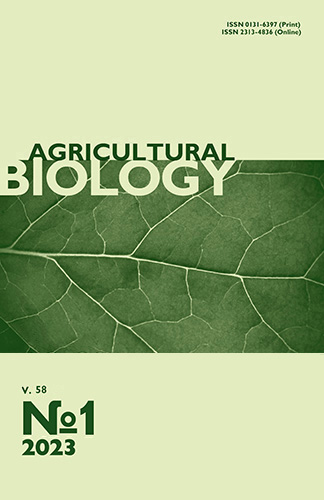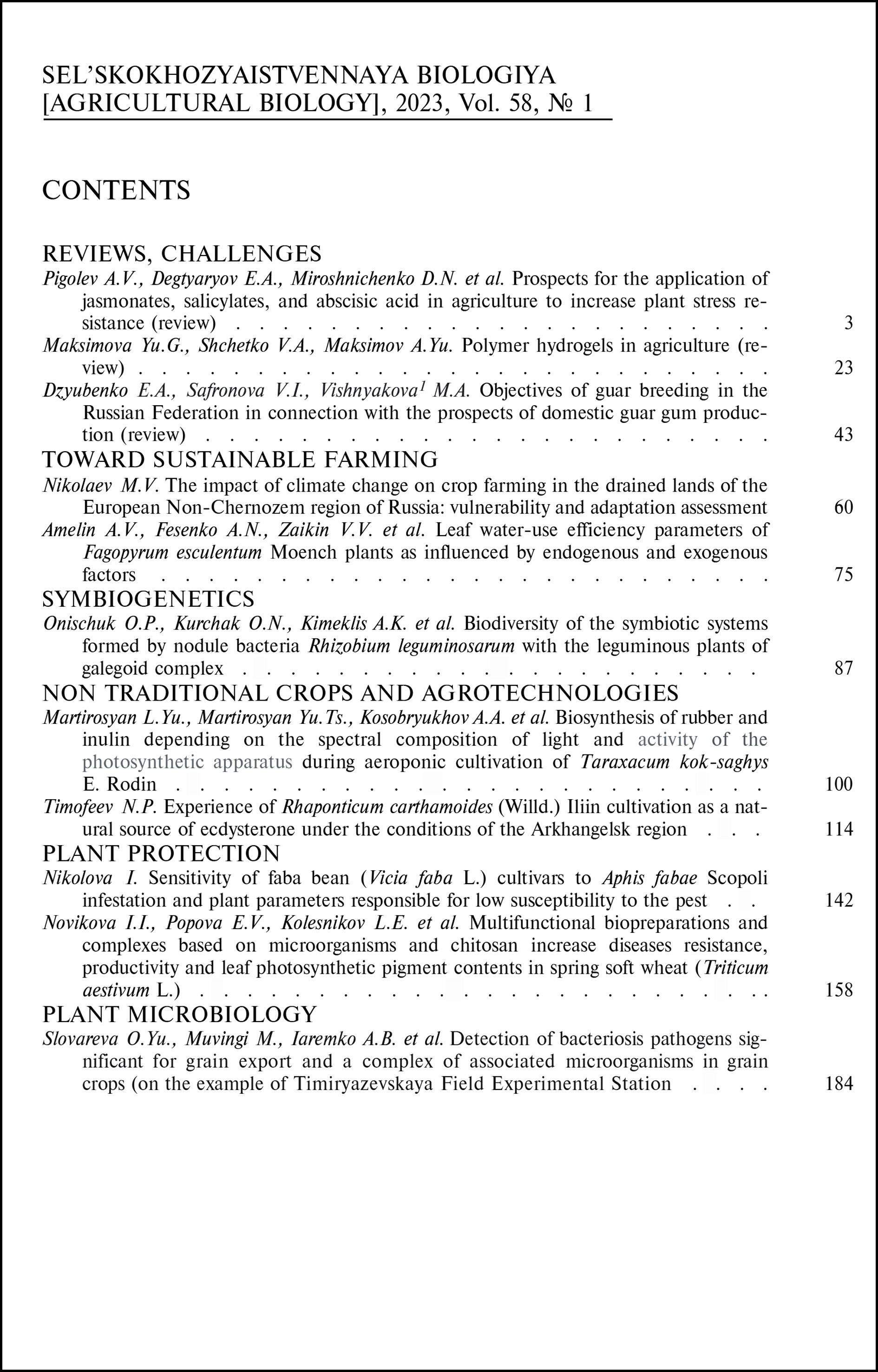doi: 10.15389/agrobiology.2023.1.100eng
UDC: 633.91:633.913.322:581.192:577.344.3:577.355
Partly supported financially with the grant from the Russian Foundation for Basic Research, project No. 20-316-90032\20
BIOSYNTHESIS OF RUBBER AND INULIN DEPENDING ON THE SPECTRAL COMPOSITION OF LIGHT AND ACTIVITY OF THE PHOTOSYNTHETIC APPARATUS DURING AEROPONIC CULTIVATION OF Taraxacum kok-saghys E. Rodin
L.Yu. Martirosyan1, 2, 5, Yu.Ts. Martirosyan1, 2 ✉,
A.A. Kosobryukhov2, 4, V.M. Goldberg1, 5, I.V. Gachok1, 3, 5,
V.V. Martirosyan2, M.A. Gladchenko3, S.N. Gaydamaka3,
A.Yu. Amerik2, A.A. Minih5, S.D. Varfolomeyev1, 3
1Emanuel Institute of Biochemical Physics RAS, 4, ul. Kosygina, Moscow, 119334 Russia, e-mail yumart@yandex.ru (✉ corresponding author), levon-agro@mail.ru, goldberg@sky.chph.ras.ru ivgachok@gmail.com, sdvarf@sky.chph.ras.ru;
2All-Russian Research Institute of Agricultural Biotechnology, 42, ul. Timiryazevskaya, Moscow, 127550 Russia, e-mail yumart@yandex.ru (✉ corresponding author), levon-agro@mail.ru, amerik.alexander@gmail.com, kosobr@rambler.ru, valentbond@mail.ru;
3Lomonosov Moscow State University, Faculty of Chemistry, 1-3 Leninskie Gory, Moscow, 119234 Russia, e-mail: vgachok@gmail.com, s.gaidamaka@gmail.com, gladmarina@yandex.ru sdvarf@sky.chph.ras.ru;
4Institute of Basic Biological Problems, 2, ul. Institutskaya, Pushchino, Moscow Province, 142290 Russia, e-mail kosobr@rambler.ru;
5OOO NTC Тatneft, Skolkovo Innovation Center, 62 A403, Bolshoy bul., Moscow, 121205 Russia, e-mail MinihAA@ntc.tatneft.ru,
levon-agro@mail.ru, ivgachok@gmail.com, goldberg@sky.chph.ras.ru
ORCID:
Martirosyan L.Yu. orcid.org/0000-0003-1769-6377
Gladchenko M.A. orcid.org/0000-0003-3233-0146
Martirosyan Yu.Ts. orcid.org/0000-0001-8825-2381
Gaydamaka S.N. orcid.org/0000-0001-5356-9776
Kosobryukhov A.A. orcid.org/0000-0001-7453-3123
Amerik A.Yu. orcid.org/0000-0003-1437-2692
Goldberg V.M. orcid.org/0000-0001-8296-6236
Minih A.A. orcid.org/0000-0001-8836-958X
Gachok I.V. orcid.org/0000-0002-5035-112X
Varfolomeyev S.D. orcid.org/0000-0003-2793-0710
Martirosyan V.V. orcid.org/0000-0003-1178-8887
Final revision received December 14, 2022
Accepted December 20, 2022
Due to the intensive development of industry and new technologies, the demand for natural rubber is increasing. The synthetic rubber cannot replace this biopolymer due to its unique consumer and operational characteristics. Along with the traditional source of natural rubber production from the latex of Brazilian Hevea Hevea brasiliensis (Willd. ex A.Juss.) Müll. Arg., work is underway to obtain it from kok-saghyz plants Taraxacum kok-saghys E. Rodin which can be grown both in natural and controlled conditions. The determination of the most favorable light conditions, taking into account the physiological state of plants, is important to obtain a high yield of target products. In this study, we have shown for the first time an increase in the rate of rubber biosynthesis when irradiating kok-saghyz plants with light with a greater proportion of blue spectrum. The paper also describes the changes in light and dark reactions of the photosynthetic apparatus, and in sucrose and glucose accumulation in plants when changing the light regime for several hours. The aim of the work was to study the influence of light conditions on the physiological and biochemical processes and biosynthesis of rubber and inulin in kok-saghyz plants grown under controlled phytotron conditions. Kok-saghyz seeds (a collection form 391 from the VIR collection of the Vavilov All-Russian Institute of Plant Genetic Resources, St. Petersburg) were germinated under sterile conditions. From days 19-20, when 3-4 true leaves appeared, the plants were grown in the aeroponic phytotron with full-spectrum light-emitting diodes (LED) of photosynthetic active radiation PAR400-700 nm of 400±28 µmol photons·m-2·s-1. In the first chamber of the phytotron, there was a 255,6 µmol photons·m-2·s-1 exposure for PAR400-700 nm blue spectrum (BS, λmax = 460 nm) and 75,6 6 µmol photons·m-2·s-1 for PAR600-700 nm red spectrum (RS, λmax = 660 nm), with the RS/BS ratio of 0.30. In the second chamber, the RS irradiation intensity (PAR600-700 nm) was 259.6 µmol photons·m-2·s-1, the BS irradiation intensity (PAR400-500 nm) was 71.8 µmol photons·m-2·s-1, with the RS/BS ratio of 3.6. The revealed parameters of growth, photosynthetic activity, and accumulation of glucose and sucrose in leaves and rubber and inulin in roots under various spectral modes during long-term growth and with changing the irradiation mode draw us to the following conclusions. When growing plants for 28 days in phytotron chambers with an increased proportion of RS in the spectrum, the content of rubber increased 3-fold, of inulin 4.1-fold compared to the initial values. With an increase in the BS proportion in PAR, the levels of rubber and inulin rose 5.4 times and 4.6 times, respectively. Ultimately, when irradiated with light with a higher proportion of BL, plants accumulated 1.75 times more rubber. The change in the irradiation spectrum from BS to RS led to a short-term increase in the concentration of glucose and sucrose in the leaves compared to the initial values. This dependence persisted for 2 hours, after which the sucrose content did not change, but there was a decrease in glucose content. When the irradiation mode changed from BS to RS, the activity of the photosynthetic apparatus decreased, i.e., the rate of photosynthesis from 26.7 to 15.2 µmol CO2·m-2·s-1 at light saturation, the rate of dark respiration from 2.80 to 2.38 µmol CO2·m-2·s-1, and the quantum yield of photosynthesis from 0.066 to 0.055. Switching from RS to BS led to opposite results. It follows from the obtained data that the change in the concentration of soluble carbohydrates in plants is associated with a change in the spectral composition of irradiation and, as a consequence, with a change in the activity of the photosynthetic apparatus. When the irradiation changed from RS to BS, there was an increase in the rate of photosynthesis and activity of photosystem II, but a decrease in the accumulation of glucose and sucrose during the first 2 hours with a return to the initial values after 3 hours.
Keywords: Taraxacum kok-saghyz, kok-saghyz, growth, rate of photosynthesis, dark transpiration, quantum yield of photosynthesis, rubber, inulin, LED light sources, phytotron, aeroponics.
REFERENCES
- Evstaf’ev S.N., Tiguntseva N.P. Izvestiya vuzov. Prikladnaya khimiya i biotekhnologiya, 2014, 1(6) (in Russ.).
- Tikhomirova L.I., Bazarnova N.G., Il’icheva T.N., Martirosyan Yu.Ts., Afanasenkova I.V. Khimiya rastitel’nogo syr’ya, 2018, 4: 235-245 (in Russ.).
- Verma N., Shukla S. Impact of various factors responsible for fluctuation in plant secondary metabolites. Journal of Applied Research on Medicinal and Aromatic Plants, 2015, 2(4): 105-113 CrossRef
- Yang L., Wen K.-S., Ruan X., Zhao Y.-X., Wei F., Wang Q. Response of plant secondary metabolites to environmental factors. Molecules,2018, 23: 762 CrossRef
- Jan R., Asaf S., Numan M., Kim K.M. Plant secondary metabolite biosynthesis and transcriptional regulation in response to biotic and abiotic stress conditions. Agronomy, 2021, 11(5): 968 CrossRef
- Wei Y.-C., Liu G.-X., Zhang L., Zhao F., Liao S., Luo M.-C. Exploring the unique characteristics of natural rubber induced by coordination interaction between proteins and Zn2+. Polymer, 2020, 193: 122357 CrossRef
- Gronover S.C., Wahler D., Prufer D. Natural rubber biosynthesis and physic-chemical studies of plant derived latex. In: Biotechnology of biopolymers. M. Elnashar (ed.). InTech, Rijeka, 2011: 75-88 CrossRef
- Cornish K. Biochemistry of natural rubber, a vital raw material, emphasizing biosynthetic rate, molecular weight and compartmentalization, in evolutionarily divergent plant species. Natural Product Report, 2001, 18(2): 182-189 CrossRef
- Cornish K. Alternative natural rubber crops: why should we care? Technology and Innovation, 2017, 18: 245-256 CrossRef
- Yager T.J., McCarty J.L. Friction characteristics of three 30 ½ 11.5-14.5, Type VIII, aircraft tires with various tread groove patterns and rubber compounds. NASA Technical Paper, 1977, 100: 1.
- Araujo-Morera J., Verdejo R., López-Manchado M.A., Santana M.H. Sustainable mobility: the route of tires through the circular economy model. Waste Management, 2021, 126: 309-322 CrossRef
- Ahrends A., Hollingsworth P.M., Ziegler A.D., Fox J.M., Chen H., Su Y., Xu J. Current trends of rubber plantation expansion may threaten biodiversity and livelihoods. Global Environmental Change, 2015, 34: 48-58.
- Amerik A.Yu., Martirosyan L.Yu., Martirosyan V.V., Martirosyan Yu.Ts. Parthenium argentatum A. Gray, Taraxacum kok-saghyz L.E. Rodin, and Scorzonera tau-saghyz Lipsch. et Bosse as alternative sources of natural rubber: do we really need them? Sel'skokhozyaistvennaya Biologiya [Agricultural Biology], 2022, 57(1): 3-26 CrossRef
- Amerik A.Yu., Martirosyan Yu.Tc., Gachok I.V. Regulation of natural rubber biosynthesis by proteins associated with rubber particles. Russian Journal of Bioorganic Chemistry, 2018, 44(2): 140-149 CrossRef
- Amerik A.Y., Martirosyan Y.T., Martirosyan L.Y., Goldberg V.M., Uteulin K.R., Varfolomeev S.D. Molecular genetic analysis of natural rubber biosynthesis. Russian Journal of Plant Physiology, 2021, 68(1): 31-45 CrossRef
- Ramirez-Cadavid D.A., Cornish K., Michel Jr F.C. Taraxacum kok-saghyz (TK): Compositional analysis of a feedstock for natural rubber and other bioproducts. Industrial Crops and Products, 2017, 107: 624-640 CrossRef
- Prokof’ev A.A. Sovetskie kauchuki, 1934, 3: 4 (in Russ.).
- Cherian S., Ryu S.B., Cornish K. Natural rubber biosynthesis in plants, the rubber transferase complex, and metabolic engineering progress and prospects. Plant Biotechnology Journal, 2019, 17(11): 2041-2061 CrossRef
- Martirosyan L.Yu., Martirosyan Yu.Ts., Varfolomeev S.D., Gol’dberg V.M. Sposob aеroponnogo vyrashchivaniya kauchukonosnogo rasteniya kok-sagyz Taraxacum kok-saghyz R. Patent RF № 2779988. Opubl. 16.09.2022. Byul. № 26 [The method of aeroponic cultivation of the rubber plant kok-saghyz Taraxacum kok-saghyz R. Patent of the Russian Federation No. 2779988. Publ. 09/16/2022. Bull. No. 26](in Russ.).
- Kutuzova S.N., Petrosyan I.A. Trudy po prikladnoy botanike, genetike i selektsii, 2011, 167: 125-132 (in Russ.).
- Kutuzova S.N., Brach N.B., Kon’kova N.G., Gavrilova V.A. Mezhdistsiplinarnyy nauchnyy i prikladnoy zhurnal «Biosfera», 2015, 7(3): 391-401 (in Russ.).
- Prioul J.L., Chartier P. Partitioning of transfer and carboxylation components of intracellular resistance to photosynthetic CO2 fixation: a critical analysis of the methods used. Annals of Botany, 1977, 41(4): 789-800 CrossRef
- Junior-PAM chlorophyll fluorometer: operator’s guide. E. Pfündel (ed.). Germany, Heinz Walz GmbH, 2007.
- Gol’tsev V.N., Kaladzhi Kh.M., Kuzmanova M.A. Allakhverdiev S.I. Peremennaya i zamedlennaya fluorestsentsiya khlorofilla a — teoreticheskie osnovy i prakticheskoe prilozhenie v issledovanii rasteniy [Variable and delayed fluorescence of chlorophyll a — theoretical foundations and practical application in plant research]. Izhevsk-Moscow, 2014 (in Russ.).
- Vorob’ev V.N., Yakushenkova T.P., Vorob’evG.V. Praktikum po fiziologii i biokhimii rasteniy. Fotosintez: uchebno-metodicheskoe posobie [Workshop on physiology and biochemistry of plants. Photosynthesis]. Kazan’, 2013 (in Russ.).
- McCleary B.V., McLoughlin C. Measurement of available carbohydrates in cereal and cereal products, dairy products, vegetables, fruit and related food products and animal feeds. Journal of AOAC INTERNATIONAL, 2021, 104(6): 1465-1478 CrossRef
- Ramirez-Cadavid D.A., Valles-Ramirez S., Cornish K., Michel Jr. F.C. Simultaneous quantification of rubber, inulin, and resins in Taraxacum kok-saghyz (TK) roots by sequential solvent extraction. Industrial Crops and Products, 2018, 122: 647-656 CrossRef
- Nelson N. A photometric adaptation of the somogyi method for determination of glucose. J. Biol. Chem., 1944, 153: 375-380.
- Voytsekhovskaya O.V. Fiziologiya rasteniy, 2019, 66(3): 163-177 CrossRef (in Russ.).
- Whitted M.G., Geher J.F., Benko A.D., Crvin A.M., Chotani K.G., Mcauliffe C.J., LaDuca J.R., Ben-Shoshan A.E., Sanford J.K. Technology update: development of a gas-phase bioprocess for isoprene-monomer production using metabolic pathway engineering. Industrial Biotechnology, 2010, 6(3): 152-163 CrossRef
- Lange I., Poirier B.C., Herron B.K., Lange B.M. Comprehensive assessment of transcriptional regulation facilitates metabolic engineering of isoprenoid accumulation in Arabidopsis. Plant Physiology, 2015, 169(3): 1595-1606 CrossRef
- Lastdrager J., Hanson J., Smeekens S. Sugar signals and the control of plant growth and development. Journal of Experimental Botany, 2014, 65(3): 799-807 CrossRef
- Ruan Y.L. Sucrose metabolism: gateway to diverse carbon use and sugar signaling. Annual Review of Plant Biology, 2014, 65: 33-67 CrossRef
- Voskresenskaya N.P. V knige: Fiziologiya fotosinteza [In: Physiology of photosynthesis]. Moscow, 1982: 203-220 (in Russ.).
- Spalholz H., Hernández R. Transplant lettuce response to different blue:red photon flux ratios in indoor LED sole-source lighting production. Acta Horticulturae, 2018, 1227: 555-562 CrossRef
- Martirosyan Yu.Ts., Martirosyan L.Yu., Kosobryukhov A.A. Dynamic regulation of photosynthetic processes under variable spectral led irradiation of plants. Sel'skokhozyaistvennaya biologiya [Agricultural Biology], 2019, 54(1): 130-139 CrossRef












